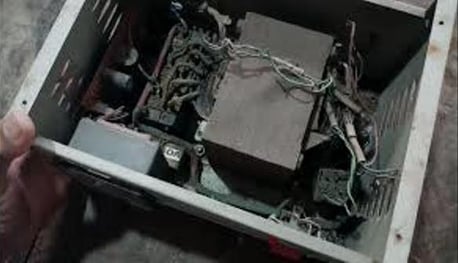The servo voltage stabilizer has been the preferred solution to correct voltage variation issues. It is used in commercial establishments, industries, offices and even homes. It has a rugged construction, works well with few causes of failures.
One must note, that when it does fail, the impacts are catastrophic. Some of the known failure mechanisms are:
- Overheating of the brush
- Neutral loss
- Transformer insulation damage
 Burnt autotransformer inside a servo stabilizer
Burnt autotransformer inside a servo stabilizer
Each of these issues posses a significant fire risk. However, we continue to use this industry workhorse, because there were no suitable alternatives. But, now there is. And it's time we think beyond the servo stabilizer. In fact now is the best time to even replace the existing servo stabilizer.
Improvements made with modern technologies
Several remarkale improvements have been made with the adoption of solid state stabilizer. Static stabilizers solved the challenges with mechanical wear & tear, hunting and correction speed. But they lacked the ability to handle motor loads that draw high startup currents. More importantly they were yet to solve issues from neutral solutions.
Smart Optimizers not only take advantage of solid state technologies, they integrate functionalities like IOT and AI to deliver a 21st century products. This is the electrical equivalent to convert a landline to a smartphone.
The Smart Optimizers deliver several advantages as compared to servo stabilizers
- Efficiency: With a peak operational efficiency of 99.4% as well as AI based voltage optimization these Smart Optimizers deliver an effective efficiency of 115%*.
- Size: The advanced solid state electronic helps to avoid electromechanical components that makes the Smart Optimizers 3X lighter and 7X smaller by volume.
.jpg?width=323&name=Comparison%20of%2030KVA%20Stabilizer%20%26%2030KVA%20POWEReasy(Front%20view).jpg) Comparison of 30KVA servo stabilizer and smart optimizer
Comparison of 30KVA servo stabilizer and smart optimizer
- Improved fault coverage: The intelligent embedded electronics can detect all 20 electrical faults and all 12 fire risks as compared to on 6 electrical risks and 3 fire faults protected by a servo stabilizer.
- IOT based remote monitoring: Build to communicate, store and analyse data on the cloud. These IOT enabled devices can monitor up to 100 million data points a year, which are automatically screened to identify the root causes. Not only that there is a command center available to guide the electrical team in solving all electrical faults.
Opportunity cost of not replacing existing stabilizers
The benefits available with the smart optimizer make it an obvious selection for new projects. For existing sites a common question is "what should we do with the existing servo stabilizer". The real question, should be, "what is the cost of not replacing the existing servo stabilizer". Table below quantifies the ongoing losses from using an existing servo stabilizer. For a 30KVA servo stabilizer one can expect an annual loss of Rs. 3,18,750 / year. Losses are experienced from the operational inefficiencies as well as the use of non-optimal voltages. Only taking the energy saving benefits in to consideration an ROI of 24 months is expected.
In addition, one of the crucial differentiation of the smart optimizer is the IOT services that enables root cause analysis for early diagnosis and prevention of electrical faults. Preventing 1 electrical breakdown a month can save 2,40,000 a year. This typically puts the cost of replacing an existing servo stabilizer to be less than 6 months!
| Annual energy usage | 37500 units |
| Losses due to stabilizer efficiency | 1125 units |
| Impact of using non-optimized voltages | 7875 units |
| Economic loss from energy consumption losses | Rs. 78,750 / year |
| Annual downtime from electrical events | 24 hours |
| Cost of production loss | Rs. 2,40,000 / year |
| Loss from using a servo stabilizer | Rs. 3,18,750 / year |
What are you waiting for?

